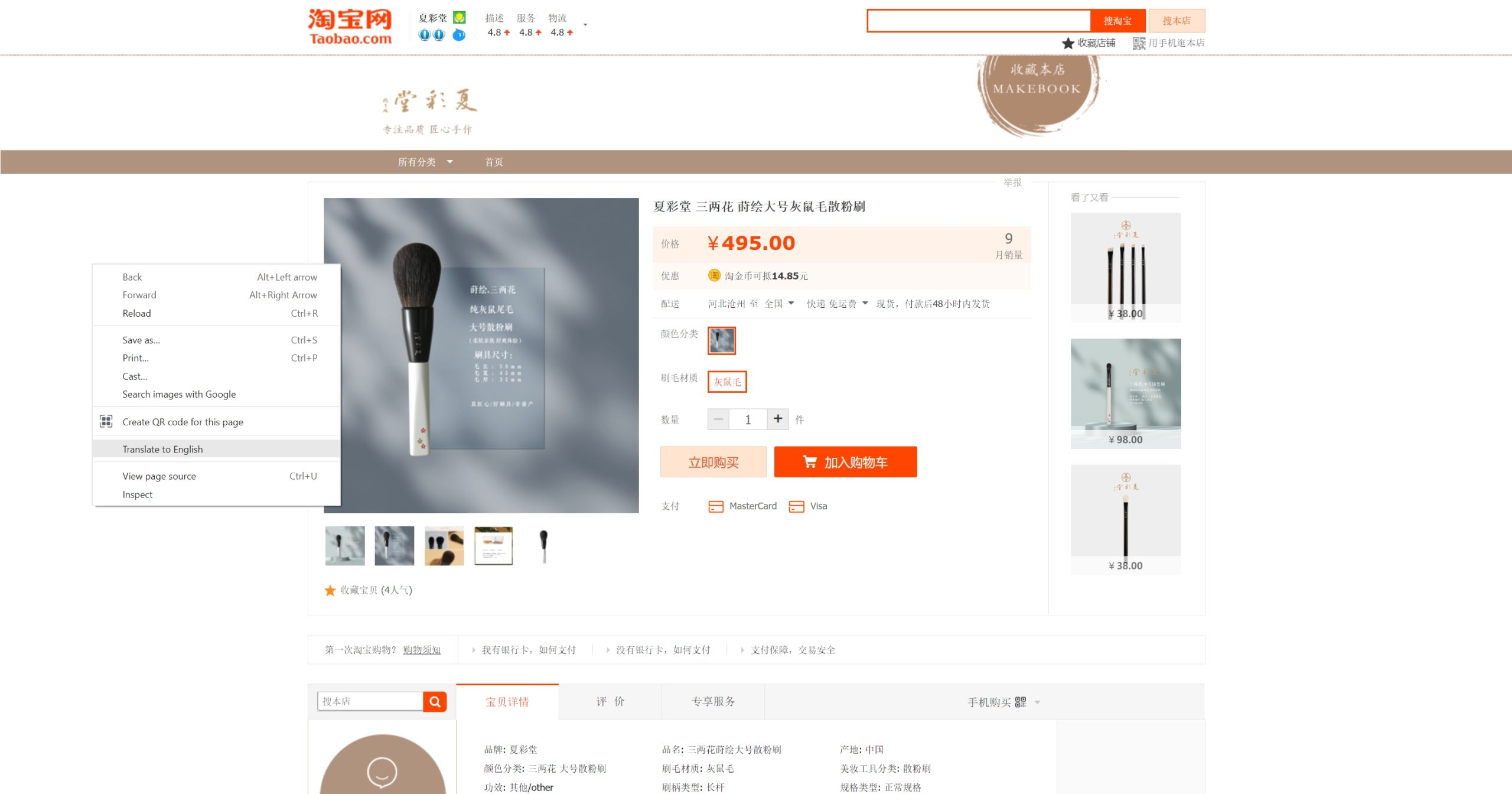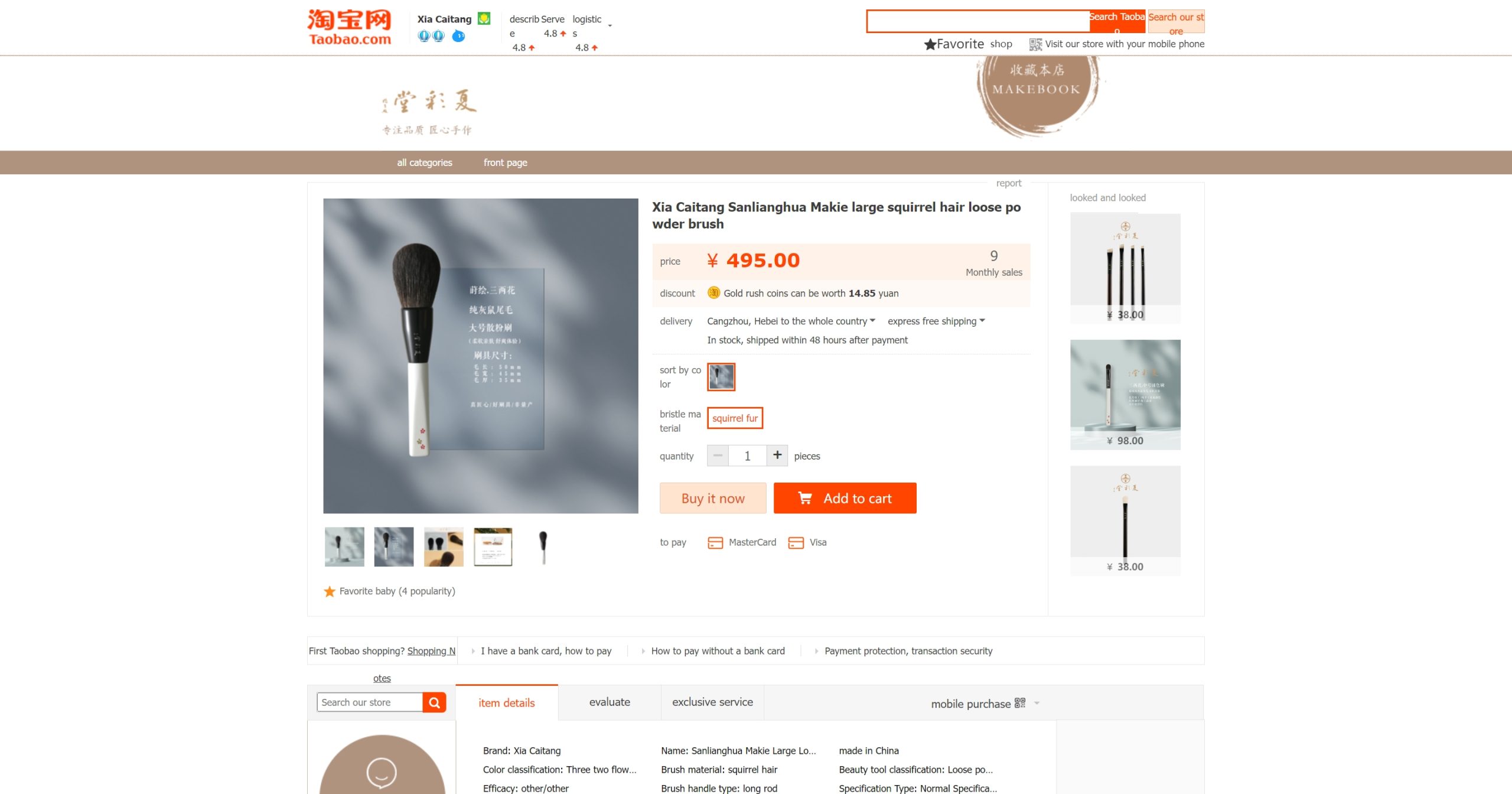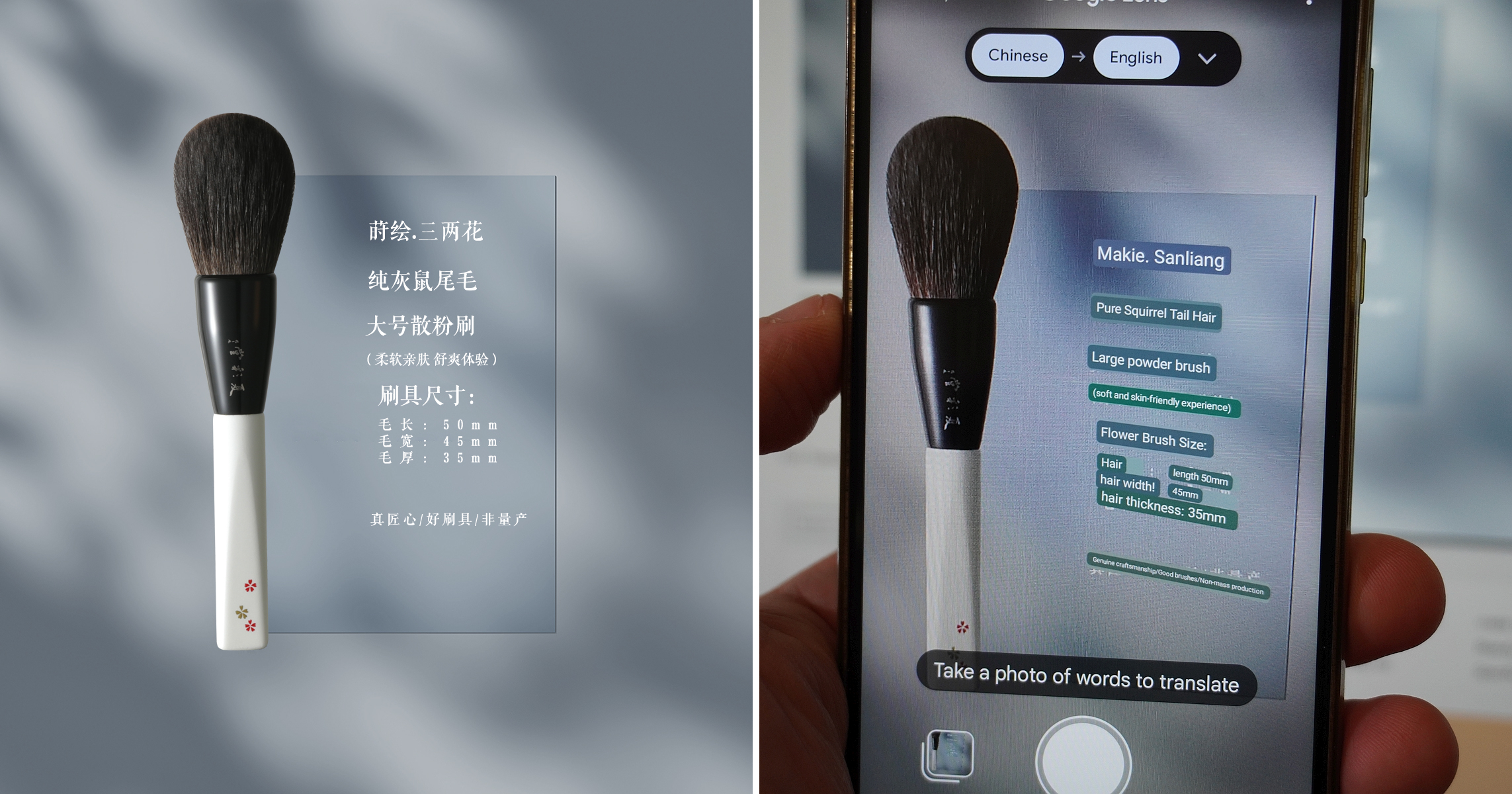I’m writing a two-part blog post to share my experience purchasing high-end (natural) Chinese makeup brushes from Taobao & Tmall. This part includes instructions on how to sign up for a Taobao & Tmall account, as well as how to navigate these Chinese marketplaces. Finally, I’ll provide you a comprehensive list of Chinese brush brands with links to their main stores.
In Part 2, I’ll outline a step-by-step procedure for purchasing these brushes through a Taobao & Tmall agent.
Taobao & Tmall vs. AliExpress
One of the first questions that inevitable arises is: “Why should someone consider purchasing makeup brushes on Taobao & Tmall when the same brushes are also available on AliExpress?” I have purchased quite a few brushes on AliExpress and I must admit that I was quite satisfied with the overall process. For starters, the stores that sell them are accessible in English, and they can ship almost anywhere in the world. This convenience, however, comes at a high cost! I was quite taken aback when I discovered that the exact same brushes were being sold on AliExpress for nearly twice as much as they were on Taobao & Tmall.
Even if you aren’t motivated by the savings because you value convenience more, there is another reason to consider Taobao & Tmall: the selection of brands and brushes on Taobao & Tmall is far greater than on AliExpress. When brands develop new brushes, they typically release them first on Taobao & Tmall, and then, if at all, on AliExpress. Limited editions and brushes made with exotic hair types may sell out immediately and never make it to AliExpress. Therefore, the ability to browse and buy brushes on Taobao & Tmall may still be beneficial to everyone.
Registering on Taobao & Tmall
It is necessary to register with Taobao & Tmall in order to view products there. Yes, you still need to create an account even if you are just browsing these websites and not making a direct purchase. Otherwise, the websites will send you straight to their login page.
You can register by clicking on the following link:
During registration, you must enter your international phone number so that you can get the verification code. After that, you’ll be prompted to select a username and password, as well as enter your e-mail address. Taobao offers this registration form in English – simply click the English button at the top of the registration page, as shown below:

It should be noted that Tmall is a sister site to Taobao, so opening up two accounts is not required. You will have access to Tmall once you have registered and signed into Taobao. On a side note, Tmall is sometimes regarded as a more upscale version of Taobao, but I do not think this actually applies to makeup brushes. High-end natural makeup brushes are available on both platforms.
Translating the Pages
Taobao & Tmall websites are in Chinese, so if you don’t know Chinese, you’ll need to figure out how to translate them into your own language. This will help you not only navigate the stores but also understand all of the important product information.
Using a Browser Translator
Most browsers have the ability to translate an entire web page. In Chrome, for example, you can simply right-click and select Translate to English. Alternatively, you can specify the origin language (Chinese) and your destination language. This will result in the outcome as shown below (drag the slider left and right to compare before and after):


This method, however, only works on parts of websites that are entered as text. When you use this method to translate a web page, you may notice that some Chinese characters remain untranslated. This is because they are Chinese characters embedded in an image rather than being actual text on a web page. I use my smartphone and the method described below to translate this type of information.
Using a Smartphone Camera
To translate information embedded in images, I use the free Google Translate app, which is available for both Android and Apple devices. The app has a camera icon that, when clicked, launches the camera feature. When you point the phone’s camera at your computer screen, it will translate all the text it sees and display the translation as an overlay in the live camera view (sort of like augmented reality). During this process, make sure the origin language is set to (Chinese or Automatic) and the destination language is set to English (or the language of your choice). Find the location where the translator app works best by moving your phone closer or farther away from the computer screen. The app tends to perform better when characters have more contrast against their background.

Understanding Product Information
As you scroll down the product listing, often you’ll see large photos of the brush from various angles, displaying its bristles, ferrule, and handle. These images frequently include Chinese characters. A photo zoomed in on the brush head will usually include the hair type and brush head dimensions, a photo zoomed in on the ferrule will include the ferrule material, and a photo zoomed in on the brush handle will include the type of wood used for the handle. I find that these images usually contain the most accurate information on the brushes, so I make sure to translate the content in these images using the aforementioned app on my phone.
Although in-browser and in-app translators are helpful, it’s important to note that they are not flawless. A literal translation from Chinese to English does not always make sense. For instance, since 纤维毛 is often translated by these translators as ‘fibre wool’, you might assume that it refers to ‘goat hair’. But in this context, ‘fibre’ actually means ‘synthetic’, and ‘wool’ actually means ‘fibre’, so it is in fact a synthetic brush. So perplexing!
You will quickly find that rather than entirely depending on English translation, it can be beneficial to learn some Chinese characters (e.g., those for various hair types) and then try to identify them in Chinese product descriptions. I have discovered this blog post, and I find it quite helpful for deciphering Chinese characters used to represent various hair types. Additionally, this table can help you understand what different types of woods are called in Chinese.
Finally, if you are aware that a specific brush is also sold on AliExpress, it is a good idea to check its product description there because they are usually accurate.
Searching for Brushes
When searching for a particular brand or hair type, keep in mind that the search bar on Taobao & Tmall performs better if you enter your query in Chinese characters. So, instead of typing Xiang She Mei Gui, paste the following into the search bar: 香舍玫瑰.
The search result will then list specific items (hopefully brushes) that match the query. However, it is important to note that not all of the displayed results will be listings from official stores. Therefore, I’ve put together a list of some of the most well-known (and a few lesser-known) Chinese manufacturers of high-end natural makeup brushes, along with links to their official/flagship stores on Taobao & Tmall.
The Ultimate Brand List with Links to Official/Flagship Stores
For each manufacturer, I’ve included their brand name, the brand name in Chinese characters, and a direct link to all of their brushes in the table below. The PRICIEST link will display all of the brushes sorted by price in descending order, with the most premium brushes (e.g., fox, squirrel, saibikoho, and weasel) appearing at the top. The NEWEST link will display the same brushes, but sorted by the date they were first listed on the website (it’s a good idea to check these regularly to see if brands have released new brushes). As most brands have many brushes, these listings will only show the first page of products. So, scroll down until you see the buttons with page numbers 1, 2, 3…. and then click on those to move onto the next page(s).
The majority of brands only have one flagship store (either on Taobao or Tmall), but a few brands have two official stores (on both Toabao and Tmall). I’ve come to realise that the listings for brands with two official stores are not identical. Yes, some brushes will be listed in both stores, but others will only be listed in one of them – so make sure to check both stores!
| BRAND NAME | CHINESE CHARACTERS | TAOBAO STORE | TMALL STORE |
|---|---|---|---|
| Xiang She Mei Gui | 香舍玫瑰 | PRICIEST | NEWEST | PRICIEST | NEWEST |
| Shou Shou Lang | 受受狼 | PRICIEST | NEWEST | PRICIEST | NEWEST |
| Qin Zhi | 琴制 | PRICIEST | NEWEST | PRICIEST | NEWEST |
| Fix+ (Fei Si Jia Fen) | 菲丝加芬 | PRICIEST | NEWEST | PRICIEST | NEWEST |
| Xia Cai Tang | 夏彩堂 | PRICIEST | NEWEST | – |
| Kong Shan Xin Yu | 空山新雨 | PRICIEST | NEWEST | – |
| Uncle Yu (Yu Da Shu) | 于大叔 | PRICIEST | NEWEST | – |
| Qiao Liang Gong | 巧良工 | PRICIEST | NEWEST | – |
| Qi Cai Shua Shua | 七彩刷刷 | PRICIEST | NEWEST | – |
| Xian Bao Lan | 仙宝兰 | PRICIEST | NEWEST | – |
| Mei Qi | 美奇 | PRICIEST | NEWEST | |
| Energy (Ai Nuo Qi) | 艾诺琪 | – | PRICIEST | NEWEST |
| Qinwuhodo (Qin Wu Tang) | 秦舞堂 | – | PRICIEST | NEWEST |
| Sumi Bear (Su Mi Xiong) | 苏米熊 | – | PRICIEST | NEWEST |
| Makeupshow (Mei Ka Hiu) | 魅卡秀 | – | PRICIEST | NEWEST |
| MSQ (Mei Si Kou) | 魅丝蔻 | – | PRICIEST | NEWEST |
| Texamo | – | – | PRICIEST | NEWEST |
| Soul Show | – | – | PRICIEST | NEWEST |
| CICI | – | – | PRICIEST | NEWEST |
Final Thoughts
I only own brushes from the brands in the top half of the table, and I don’t have any experience with the brands in the lower half. As a result, I can’t really comment on the quality of the latter brands other than the fact that they appear to offer at least a few makeup brushes made of natural hair. I’m still providing these links, though, in case you want to look into them. I hope to add to this table in the future, as I come across more Chinese producers of natural-hair makeup brushes.
If you’re already familiar with Taobao & Tmall and want to learn how to actually purchase these brushes, please proceed to Part 2 of this tutorial.
